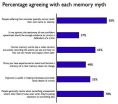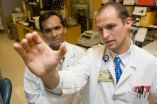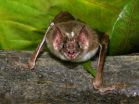(Press-News.org) PORTLAND, Ore. — A signaling system in the brain previously shown to regulate sleep is also responsible for inducing lethargy during illness, according to research conducted at Oregon Health & Science University Doernbecher Children's Hospital.
This research is particularly meaningful because it implies that a new class of drugs developed to treat sleep disorders can reverse the inactivity and exhaustion brought on by acute illness. Although the sleep drugs were initially designed to treat narcolepsy, they have the potential to restore energy and motivation in patients with acute and chronic disease, the researchers report. Their findings are published in the The Journal of Neuroscience.
"We all know what it means to feel 'bad' when we're acutely ill. In particular, patients with chronic diseases experience a compromise in motivated behaviors. They don't feel like getting up and doing anything. Yet the brain mechanisms behind this common experience have remained obscure," said Daniel L. Marks, M.D., Ph.D., principal investigator and associate professor of pediatrics in the Papé Family Pediatric Research Institute at OHSU Doernbecher Children's Hospital.
"Our lab has found that the neurotransmitter system thought to be primarily involved in the induction of sleep is actually extremely important in maintaining motivation and movement during acute and chronic illness," Marks explained.
Research has shown that in response to illness, animals divert all their energy to fight infection. Lethargy, fever and loss of appetite are symptoms of the body's highly organized strategy to sacrifice biological and physiological priorities to provide the greatest chance of survival.
Although previous studies have identified the neurotransmitter system in the brain responsible for inducing fever and loss of appetite in response to disease, the mechanism for suppressing physical activity and motivation, and the means to treat it, has been unclear — until now.
To determine the cause of illness-induced lethargy, Marks and colleagues studied the brains of rats, the neuroactivity of which closely mimics human brains. They determined that acute and chronic inflammation-induced lethargy is brought about by a specific population of inflammation-sensitive neurons located near the neurotransmitter system that controls physical activity and arousal, known as the orexin system. When the researchers injected the rats with orexin, they were able to restore orexin signaling and, thus, restore motivated behaviors and movement.
This research demonstrates that orexin replacement is a viable therapeutic avenue for sickness-induced lethargy, the researchers explain. Because chronic disruption of this crucial neurotransmitter system leads to profound sleep disturbance and loss of motivated behaviors, they propose that drugs that mimic orexin would be useful in chronically ill patients to improve quality of life and independent living.
"There is a very exciting opportunity to quickly translate these findings into clinical practice," Marks said. "Because the role of orexin in sleep disorders like narcolepsy has been known for several years, the drug development efforts aimed at restoring orexin signaling are at an advanced state and nearly ready for clinical application."
###
The study, "Inflammation-induced lethargy is mediated by suppression of orexin neuron activity," was funded by the National Institutes of Health.
Other members of the research team include: Aaron Grossberg, XinXia Zhu, Pete Levasseur, and Theodore Braun, all of Oregon Health & Science University; and Gina Marie Leinninger and Martin Myers, of the University of Michigan
About OHSU Doernbecher Children's Hospital
OHSU Doernbecher Children's Hospital is ranked among the nation's top 50 children's hospitals in eight specialties.* Each year OHSU Doernbecher cares for tens of thousands of children from Oregon, southwest Washington and beyond in the most patient- and family-centered environment. OHSU Doernbecher's nationally recognized experts provide a full range of pediatric care resulting in more than 195,000 outpatient visits, discharges, surgeries and transports annually. Its experts travel throughout Oregon and southwest Washington to provide specialty care to some 3,000 children at more than 154 outreach clinics in 13 locations.
* US News Best Children's Hospitals 2011-12.
END
A new customised IT business management system developed by Queensland University of Technology (QUT) researchers and capable of improving the scheduling of resources and workflow in surgical theatres has been successfully demonstrated in a German hospital.
Dr Chun Ouyang, from QUT's Business Process Management (BPM) group, said the system was built based on an automated workflow system known as YAWL, and allowed hospitals to more efficiently manage the co-ordination of expensive surgery-related resources.
The project is being undertaken in partnership with German ...
WASHINGTON – The American Psychological Association plans to feature three public demonstrations of psychological science applications, including one that enables "seeing" with one's ears rather than eyes, at the organization's 119th Annual Convention here this week.
The Science Showcase will be open to the public Aug. 5 and 6, near the entrance to the convention exhibits and registration area at the Walter E. Washington Convention Center.
"The science of psychology affects everyone's daily life in ways that most people don't realize," said Steven J. Breckler, ...
CHAMPAIGN, Ill. — A new survey reveals that many people in the U.S. – in some cases a substantial majority – think that memory is more powerful, objective and reliable than it actually is. Their ideas are at odds with decades of scientific research.
The results of the survey and a comparison to expert opinion appear in a paper in the journal PLoS ONE.
(Before reading further, test your own ideas about memory.)
"This is the first large-scale, nationally representative survey of the U.S. population to measure intuitive beliefs about how memory works," said University ...
VIDEO:
People who live to 95 or older are no more virtuous than the rest of us in terms of their diet, exercise routine or smoking and drinking habits, according to...
Click here for more information.
August 3, 2011 — (Bronx, NY) — People who live to 95 or older are no more virtuous than the rest of us in terms of their diet, exercise routine or smoking and drinking habits, according to researchers at Albert Einstein College of Medicine of Yeshiva University.
Their findings, ...
ROCHESTER, Minn. -- A new tick-borne bacterium infecting humans with ehrlichiosis has been discovered in Wisconsin and Minnesota. It was identified as a new strain of bacteria through DNA testing conducted at Mayo Clinic. The findings appear in the Aug. 4 edition of the New England Journal of Medicine.
Doctors at Mayo Clinic, the Centers for Disease Control and Prevention (CDC), the University of Minnesota, the University of Wisconsin, and state and local health departments say the new species from the Ehrlichia genus can cause a feverish illness in humans. The new bacterium, ...
A comparison clinical study of two aplastic anemia treatments found that ATGAM, currently the only licensed aplastic anemia drug in the United States, improved blood cell counts and survival significantly more than did Thymoglobulin, a similar but reportedly more potent treatment. The research was funded by the National Heart, Lung, and Blood Institute (NHLBI), a part of the National Institutes of Health; the study participants were treated and then followed at the NIH Clinical Center in Bethesda, Maryland.
The study will appear in the August 4 New England Journal of ...
BC Children's Hospital and University of British Columbia (UBC) researchers have found that two existing screening tests are accurate in diagnosing development delays in children and could be incorporated in a busy family practice setting with relative ease.
Parents can complete the Ages and Stages Questionnaire (ASQ) or the Parents' Evaluation of Developmental Status (PEDS) at home or in the family physician's office, with the physician scoring the tests and providing results in a matter of minutes.
"Only 30 per cent of children with developmental delays are identified ...
ANN ARBOR, Mich. — A new urine test can help aid early detection of and treatment decisions about prostate cancer, a study from the University of Michigan Comprehensive Cancer Center and the Michigan Center for Translational Pathology finds.
The test supplements an elevated prostate specific antigen, or PSA, screening result, and could help some men delay or avoid a needle biopsy while pointing out men at highest risk for clinically significant prostate cancer.
The test looks for a genetic anomaly that occurs in about half of all prostate cancers, an instance of two ...
SALT LAKE CITY, Aug. 3, 2011 – University of Utah scientists used chemical isotopes in ancient soil to measure prehistoric tree cover – in effect, shade – and found that grassy, tree-dotted savannas prevailed at most East African sites where human ancestors and their ape relatives evolved during the past 6 million years.
"We've been able to quantify how much shade was available in the geological past," says geochemist Thure Cerling, senior author of a study of the new method in the Thursday, Aug. 4, 2011 issue of the journal Nature. "And it shows there have been open ...
Scientists have known for years that when vampire bats tear through an animal's skin with their razor-sharp teeth, their noses guide them to the best spots – where a precise bite will strike a vein and spill forth nourishing blood. But nobody knew exactly how bats knew where to bite.
By investigating wild vampire bats in South America, researchers at the University of California, San Francisco and Instituto Venezolano de Investigaciones Científicas in Caracas, Venezuela have discovered their secret: a sensitive, heat-detecting molecule covering nerve endings on their ...



